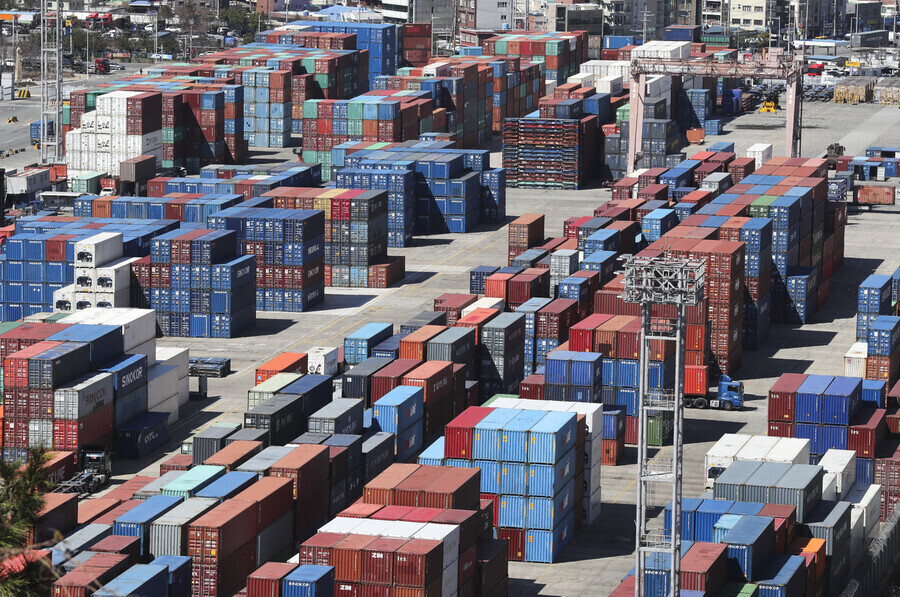hankyoreh
Links to other country sites 다른 나라 사이트 링크
South Korea creates more US jobs via direct investment than any other county

South Korean companies accounted for the largest share of jobs created by foreign companies through direct investment in the US market. As global supply chain reorganization and accelerated overseas investment have significantly weakened the spillover effect of South Korea’s booming semiconductor exports on the domestic market, the decoupling between Korea’s domestic economy and the US economy is becoming more pronounced.
According to a report on trends in US reshoring announcements and foreign direct investment in the first half of 2023 by the Reshoring Initiative, a nonprofit lobbying organization in the US, a total of 182,800 new jobs were created in the US market in the first half of 2023 (108,300 from reshoring and 74,500 from direct investment). There was a combined total of 807 instances of reshoring and direct investment.
By country, job contribution rates were 17% for South Korea, 15% for the UK, 11% for Germany, 9% for China, and 9% for Japan.
On average, South Korea created an average of 393 jobs for each direct investment in the US. Among the 50 US states, Kentucky (14%) and Georgia (10%) accounted for the largest number of jobs through reshoring and FDI, with South Korean companies creating many jobs in Kentucky through the Ford/SK Blue Oval partnership, and Georgia through Hyundai Motor Company.
The number of jobs attributed to reshoring and FDI cases in the US has been growing rapidly, with 98,700 jobs in 2019, 156,300 in 2020, 244,800 in 2021, 343,700 in 2022, and 365,700 projected jobs in 2023.
Some analysts believe that the recent semiconductor industry boom has already broken the relationship that led to an increase in domestic demand, including domestic capital expenditure, as capex has been concentrated in the US during the global supply chain adjustment after the COVID-19 pandemic. Despite the recent highs of the semiconductor cycle, the import growth rate of machinery for semiconductor manufacturing (month-on-month and year-on-year) has turned negative since March 2024.
“Unlike in the past, strong semiconductor exports are not translating into domestic capex and employment,” said Kang Seung-won, an analyst for NH Investment & Securities. Kang says that despite the base effect of a sharp decline in capex (-25.3% year-on-year) due to the sluggish chip industry in 2023, the combined capex growth of Samsung Electronics and SK Hynix is expected to be only 15.4% (year-on-year) in 2024.
The dualized structure of strong exports and sluggish domestic demand is due to the fact that the ripple effect of exports on domestic demand has been greatly weakened by the COVID-19 pandemic.
Statistics Korea’s export diffusion index (a three-month moving average of the number of 135 major export items whose exports increased more than imports, calculated as a percentage of the previous month’s exports) has been below the baseline (=50, above which the index indicates expansion, below which it indicates contraction) every month in 2024 (through April). While overall exports, led by semiconductors, have increased (year-on-year) for eight consecutive months through May, the overall manufacturing (domestic) economy of exported goods has yet to show signs of expansion.
By Cho Kye-wan, senior staff writer
Please direct questions or comments to [english@hani.co.kr]

Editorial・opinion
![[Column] The miscalculations that started the Korean War mustn’t be repeated [Column] The miscalculations that started the Korean War mustn’t be repeated](https://flexible.img.hani.co.kr/flexible/normal/500/300/imgdb/original/2024/0630/9717197068967684.jpg) [Column] The miscalculations that started the Korean War mustn’t be repeated
[Column] The miscalculations that started the Korean War mustn’t be repeated![[Correspondent’s column] China-Europe relations tested once more by EV war [Correspondent’s column] China-Europe relations tested once more by EV war](https://flexible.img.hani.co.kr/flexible/normal/500/300/imgdb/original/2024/0628/7617195640940814.jpg) [Correspondent’s column] China-Europe relations tested once more by EV war
[Correspondent’s column] China-Europe relations tested once more by EV war- [Correspondent’s column] Who really created the new ‘axis of evil’?
- [Editorial] Exploiting foreign domestic workers won’t solve Korea’s birth rate problem
- [Column] Kim and Putin’s new world order
- [Editorial] Workplace hazards can be prevented — why weren’t they this time?
- [Editorial] Seoul failed to use diplomacy with Moscow — now it’s resorting to threats
- [Column] Balloons, drones, wiretapping… Yongsan’s got it all!
- [Editorial] It’s time for us all to rethink our approach to North Korea
- [Column] Why empty gestures matter more than ever
Most viewed articles
- 1[Column] The miscalculations that started the Korean War mustn’t be repeated
- 2Blaze at lithium battery plant in Korea leaves over 20 dead
- 3CIA record confirms US ‘completely destroyed’ Seoul’s Haebangchon in 1950 bombardment
- 4Dreams of a better life brought them to Korea — then a tragic fire tore them apart
- 5[Correspondent’s column] Who really created the new ‘axis of evil’?
- 6[Editorial] Seoul failed to use diplomacy with Moscow — now it’s resorting to threats
- 7[Editorial] Exploiting foreign domestic workers won’t solve Korea’s birth rate problem
- 8Moscow tells Seoul to rethink ‘confrontational course’
- 9Yoon echoed conspiracy theories about Itaewon disaster, former National Assembly speaker says
- 10South Korea creates more US jobs via direct investment than any other county